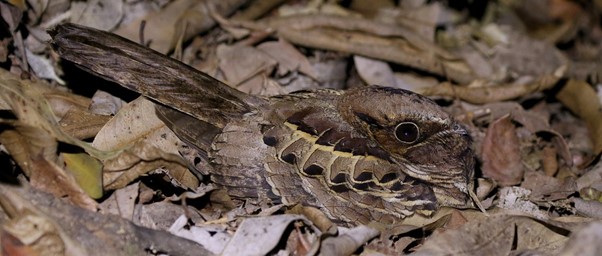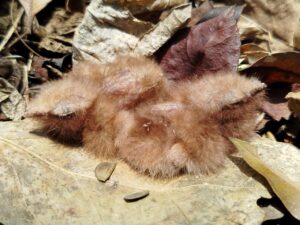
This unusual bird has long been a source of myth and legend throughout South America. In Colombia, our partner Proyecto Tití’s is protecting its forest home. Credit: Lee Dingain
In the forests of South America, myths have long surrounded the Common Pauraque (Nyctidromus albicollis). In Costa Rica, its call each April and May is said to summon the rains. In Peru, the Indigenous Uitoto believe it to be the abandoned son of the moon, saying that on clear nights it stares skywards crying out the rebuke “Tuhayo! Tuhayo!” – “I am your fruit!”. Elsewhere, it was thought to bring love – an unhappy belief for this small bird, with its tiny heart and bones ground down into powder for potions and amulets.
But in Colombia, it is the Night Guardian – a protector of the forest destined to make careless intruders dizzy and lost by spinning them in circles. Although mischievous, its intentions are good, and it stops once the intruder has learned to slow down and respect the forest’s silence.
Behind these myths lie an elusive bird that is a master of disguise.
Hidden in plain sight
The Common Pauraque is a member of the nightjar family and is found in both North and South America. A nocturnal bird, it roosts during the day, lying flat on the forest floor or along branches and logs. Its plumage – a marbled blend of greys and browns – mimics leaf litter so perfectly that they become almost invisible.
At night, however, the Pauraque is easy to identify from its loud and extremely varied call. From sunset to sunrise, it fills the air with an unusual soundtrack, settling territorial disputes with whistles, whoops, grunts, and growls.
Although very vocal, the Common Pauraque hunts in silence – flying low and fast to catch its prey in the dark. With precious little light reaching the forest floor, the Pauraque needs every photon it can get. For this, its eyes contain a reflective layer, the tapetum lucidim. Located behind the retina, this acts like a mirror, bouncing light back through the retina and giving it a second chance to pick up light. Also found in cats and many other nocturnal animals, this mirrored layer creates the eerie eyeshine seen under torchlight.

A second chance to see: the tapetum lucidim is a reflective layer behind the eye that contributes to the eyeshine seen here. Credit: Scott Guiver
Even this reflected light is not always enough however, which is why the Common Pauraque also uses touch to find its prey. Its wide mouth is ringed by whisker-like bristles which help it catch any unwitting insects that stray too close.
A sanctuary for the night guardian
Our conservation partner Proyecto Tití is protecting the forest home of the Common Pauraque and many other extraordinary species in northern Colombia. During a recent biodiversity survey, the team discovered two of its eggs carefully hidden among dry leaves on the ground – buff-coloured and speckled with cinnamon and grey. Days later, they hatched, and two healthy young chicks emerged – future night guardians of the forest.

Two young Common Pauraque chicks recently spotted by Proyecto Tití during a biodiversity survey in the forests of northern Colombia. Credit: Proyecto Tití
“It was a special moment that reminded us of the importance of walking with attention and respecting the wildlife,” says Rosamira Guillen, Proyecto Tití’s Executive Director.
“The Common Parauque is not just part of legend. It’s also a symbol of life that endures, of the night that protects, and of the forest that never ceases to surprise us.”
If you have enjoyed this article, please consider supporting our work to protect the world’s most threatened habitats and species.


